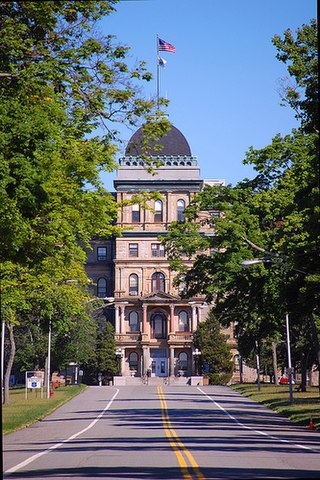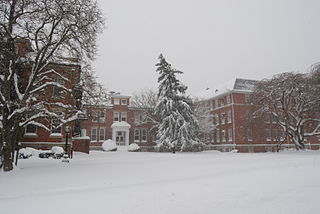
The Waverly Hills Sanatorium is a former sanatorium located in the Waverly Hills neighborhood of Louisville, Kentucky.

Taunton State Hospital is a psychiatric hospital located on Hodges Avenue in Taunton, Massachusetts. Established in 1854, it was originally known as the State Lunatic Hospital at Taunton. It was the second state asylum in Massachusetts. Most of the original part of the facility was built in a unique and rare neo-classical style designed by architects Boyden & Ball. It is also a Kirkbride Plan hospital and is located on a large 154-acre (62 ha) farm along the Mill River.

Greystone Park Psychiatric Hospital referred to both the former psychiatric hospital and the historic building that it occupied in Morris Plains, New Jersey. Built in 1876, the facility was built to alleviate overcrowding at the state's only other "lunatic asylum" located in Trenton, New Jersey.
Springfield Hospital Center is a regional psychiatric hospital located in Sykesville, Maryland, United States. It first opened in 1896.

The Crownsville Hospital Center was a psychiatric hospital located in Crownsville, Maryland. It was in operation from 1911 until 2004.

The Philadelphia State Hospital at Byberry was a psychiatric hospital located on either side of Roosevelt Boulevard in Northeast Philadelphia, Pennsylvania. It was specifically located in the Somerton section of the city on the border with Bucks County. The name of the institution was changed several times during its history being variously named Philadelphia State Hospital, Byberry State Hospital, Byberry City Farms, and the Philadelphia Hospital for Mental Diseases. It was home to people ranging from the mentally challenged to the criminally insane.

The Rosewood Center was an institution for people with developmental disabilities located on Rosewood Lane in Owings Mills, Maryland.
Mendota Mental Health Institute (MMHI) is a public psychiatric hospital in Madison, Wisconsin, United States, operated by the Wisconsin Department of Health Services. The hospital is accredited by the Joint Commission. Portions of the facility are included in the Wisconsin Memorial Hospital Historic District, District #88002183. The Mendota State Hospital Mound Group and Farwell's Point Mound Group are also located at the facility.

The Hudson River State Hospital is a former New York state psychiatric hospital which operated from 1873 until its closure in the early 2000s. The campus is notable for its main building, known as a "Kirkbride," which has been designated a National Historic Landmark due to its exemplary High Victorian Gothic architecture, the first use of that style for an American institutional building. It is located on US 9 on the Poughkeepsie-Hyde Park town line.
Undercliff State Hospital was a roughly 40-acre (16 ha) hospital situated on Undercliff Road, Meriden, Connecticut. It operated from 1910 to 1976. The hospital was first built under the name Meriden Sanatorium to serve children with tuberculosis, German measles, chickenpox, and smallpox, but began to accept adult patients in 1939. In the early 1920s, the site name was changed to Undercliff Sanatorium. In 1967, it was changed once again to Undercliff Mental Health Center.

The Arkansas Tuberculosis Sanatorium Historic District is a United States Historic District south of Booneville, Arkansas that was listed on the National Register of Historic Places in October 2006. The district encompasses the former relocation center for Arkansans diagnosed with tuberculosis and an administration building built in the Art Deco style in 1909. It is one of the largest and best-preserved surviving complexes of its type in the country.

Cranberry Specialty Hospital was a tuberculosis sanatorium and later a chronic care facility in Hanson, Massachusetts operated by Plymouth County, Massachusetts, which was operational from 1919 until 1992.

The Minnesota State Sanatorium for Consumptives, also known as the Ah-Gwah-Ching Center, was opened in 1907 to treat tuberculosis patients. The name "Ah-Gwah-Ching" means "out-of-doors" in the Ojibwe language. The center remained a treatment center for tuberculosis until January 1, 1962. During that time, it treated nearly 14,000 patients. In 1962, it became a state nursing home known as the Ah-Gwah-Ching Nursing Home, serving geriatric patients with various mental and physical illnesses. At its peak in the 1970s, the nursing home had as many as 462 patients.
Pine Bluff State Hospital was a tuberculosis sanatorium and isolation hospital in Salisbury, Maryland, in the United States. The hospital was built by The Pine Bluff Sanatorium Company. The hospital grounds contain three parcels, the first is 0.46 acres (0.19 ha), the second is 1.534 acres (0.621 ha), and the third 8.35 acres (3.38 ha).
St. Marys College was a Roman Catholic school in Ilchester, Maryland near modern Ellicott City, Maryland in Howard County. The ruins are near Ilchester and Bonnie Branch roads. The upper college building was built in 1868 consisting of a cupola topped eighteen bay by five bay building with a five by five bay projection. A three by three bay, five story "L" shaped addition is included, with all of the structure on a stone foundation. A three-story chapel was attached to the building in 1882. In 1934 a fifth floor was added throughout. A statue of Madonna with Child was situated in a niche.
Thistle Manufacturing Company factory was a historic factory located along the Patapsco River, which runs through Catonsville, Maryland across from Ilchester, Maryland. The 1800s factory was in continuous operation until 2003.
Woodlawn or Papillon was amanor home in Ellicott City, Howard County, Maryland in the United States.

The Racine County Insane Asylum was a mental hospital, operated by the County of Racine, Wisconsin, from 1889 to the 1970s.
Hassler Health Farm, formerly known as San Francisco Health Farm between 1927 and 1931, was a tuberculosis sanatorium for patients of the San Francisco Bay Area, owned by the City of San Francisco. It was located in a remote part of San Mateo County, California, in what is today San Carlos, until 1964. After the discovery of antibiotics, tuberculosis became a reduced threat, leading the building to be converted into a hospital for the poor. It was closed in 1972 and sat empty until 1985, when the buildings were demolished. Today, the grounds are home to the 366-acre Pulgas Ridge Open Space Preserve.














